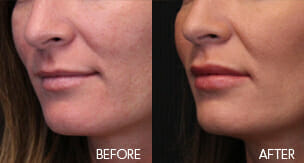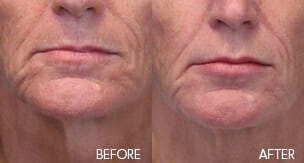Melanoma can appear as a new mole, a darkening/black mole or a mole that is changing shape or size. Change is one of the most important considerations. Itching or bleeding without trauma are also symptoms which should be discussed with a dermatologist. Melanoma occurs most commonly on the back in men and the legs in women. Its incidence has continued to increase with some reports suggesting 1 in 35 men and 1 in 25 women will be affected during their lifetime. In women, ages 25-35, it is the leading cause of cancer death. A recent study in Ireland has also outlined an association between melanoma and breast cancer in women. Studies have demonstrated a clear link between sun exposure and melanoma. The UVA rays in tanning beds have also been linked to increased incidence of melanoma. Melanoma can spread to other parts of the body but if caught early it is often curable. Melanoma continues to be the most deadly form of skin cancer.
Basal cell carcinoma (BCC) and squamous cell carcinoma (SCC) present differently than melanoma and are much more common. Some studies estimate that 1 in 8 Americans will be affected by one of these two skin cancers. Generally, BCC and SCC occur as new skin-colored to pink, sometimes scaled bumps on the skin. They may bleed frequently, increase quickly in size over a short period of time and become painful or tender. They occur commonly on the scalp, face and chest of men and face and legs of women. As with melanoma, sun exposure is a key factor in the development of BCCs and SCCs. This is generally a product of time and cumulative exposure affecting mostly older individuals over the age of 50 but can also occur in patients as young as 20-years-old. Although less likely than melanoma to spread to other parts of the body, BCC and SCC can overtime, invade other parts of the body. BCC and SCC are most often treated with surgical excision which is usually curative. For certain types of skin cancer, and for specific locations on the body, a specialized type of skin cancer surgery known as Mohs surgery can be performed.
If you are concerned you may have a skin cancer, you should contact your dermatologist as soon as possible to arrange for an evaluation.
MOLES & MELANOMA
Moles or Nevi, are collections of melanocytes within the skin. Their production of melanin explains their brown coloring. Most moles represent benign (non-cancerous) growths. They can be round, flat, bumpy, grow hair and over time become soft and lose their brown coloring. Others look lied fried eggs with a darker center and lighter rim and still others are very large with abnormal borders. Benign moles can have all of these different appearances. Unfortunately, melanoma can sometimes look similar. When evaluating your own moles, look for the “ugly duckling” (one of these is not like the others) mole, the one that doesn’t look like any of your other moles. If you can’t find a similar looking mole elsewhere and your “ugly duckling” mole has any worrisome features as noted below in the ABCDE section, please bring it to the attention of a dermatologist.
ABCDE’S OF MOLES AND MELANOMA
A – Asymmetry: If you divide your mole in half and fold it onto itself, is one half like the other?
B – Border: Is the border smooth or jagged, notched etc?
C – Color: Is your mole entirely the same color? Is your mole black instead of brown?
D – Diameter: Is your mole larger than a pencil eraser?
E – Evolution: Has your mole changed?






